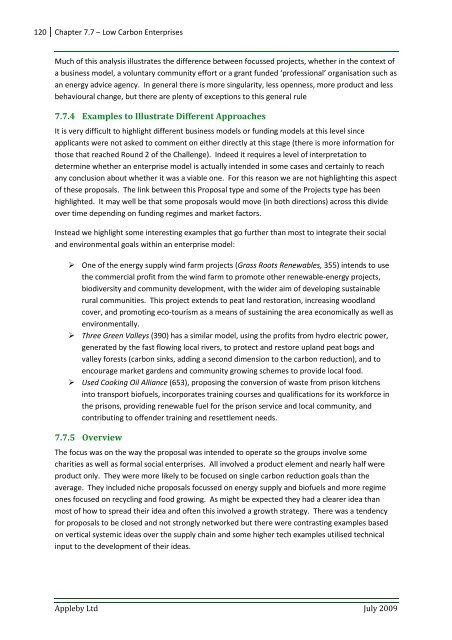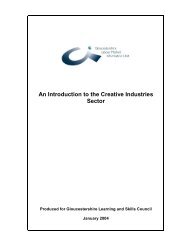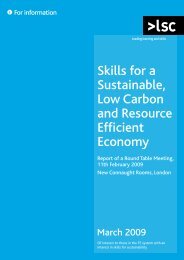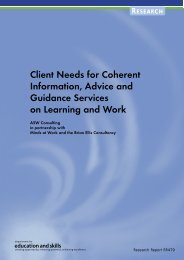Mapping the Big Green Challenge - The Skills & Learning ...
Mapping the Big Green Challenge - The Skills & Learning ...
Mapping the Big Green Challenge - The Skills & Learning ...
You also want an ePaper? Increase the reach of your titles
YUMPU automatically turns print PDFs into web optimized ePapers that Google loves.
120 Chapter 7.7 – Low Carbon EnterprisesMuch of this analysis illustrates <strong>the</strong> difference between focussed projects, whe<strong>the</strong>r in <strong>the</strong> context ofa business model, a voluntary community effort or a grant funded ‘professional’ organisation such asan energy advice agency. In general <strong>the</strong>re is more singularity, less openness, more product and lessbehavioural change, but <strong>the</strong>re are plenty of exceptions to this general rule7.7.4 Examples to Illustrate Different ApproachesIt is very difficult to highlight different business models or funding models at this level sinceapplicants were not asked to comment on ei<strong>the</strong>r directly at this stage (<strong>the</strong>re is more information forthose that reached Round 2 of <strong>the</strong> <strong>Challenge</strong>). Indeed it requires a level of interpretation todetermine whe<strong>the</strong>r an enterprise model is actually intended in some cases and certainly to reachany conclusion about whe<strong>the</strong>r it was a viable one. For this reason we are not highlighting this aspectof <strong>the</strong>se proposals. <strong>The</strong> link between this Proposal type and some of <strong>the</strong> Projects type has beenhighlighted. It may well be that some proposals would move (in both directions) across this divideover time depending on funding regimes and market factors.Instead we highlight some interesting examples that go fur<strong>the</strong>r than most to integrate <strong>the</strong>ir socialand environmental goals within an enterprise model: One of <strong>the</strong> energy supply wind farm projects (Grass Roots Renewables, 355) intends to use<strong>the</strong> commercial profit from <strong>the</strong> wind farm to promote o<strong>the</strong>r renewable-energy projects,biodiversity and community development, with <strong>the</strong> wider aim of developing sustainablerural communities. This project extends to peat land restoration, increasing woodlandcover, and promoting eco-tourism as a means of sustaining <strong>the</strong> area economically as well asenvironmentally. Three <strong>Green</strong> Valleys (390) has a similar model, using <strong>the</strong> profits from hydro electric power,generated by <strong>the</strong> fast flowing local rivers, to protect and restore upland peat bogs andvalley forests (carbon sinks, adding a second dimension to <strong>the</strong> carbon reduction), and toencourage market gardens and community growing schemes to provide local food. Used Cooking Oil Alliance (653), proposing <strong>the</strong> conversion of waste from prison kitchensinto transport biofuels, incorporates training courses and qualifications for its workforce in<strong>the</strong> prisons, providing renewable fuel for <strong>the</strong> prison service and local community, andcontributing to offender training and resettlement needs.7.7.5 Overview<strong>The</strong> focus was on <strong>the</strong> way <strong>the</strong> proposal was intended to operate so <strong>the</strong> groups involve somecharities as well as formal social enterprises. All involved a product element and nearly half wereproduct only. <strong>The</strong>y were more likely to be focused on single carbon reduction goals than <strong>the</strong>average. <strong>The</strong>y included niche proposals focussed on energy supply and biofuels and more regimeones focused on recycling and food growing. As might be expected <strong>the</strong>y had a clearer idea thanmost of how to spread <strong>the</strong>ir idea and often this involved a growth strategy. <strong>The</strong>re was a tendencyfor proposals to be closed and not strongly networked but <strong>the</strong>re were contrasting examples basedon vertical systemic ideas over <strong>the</strong> supply chain and some higher tech examples utilised technicalinput to <strong>the</strong> development of <strong>the</strong>ir ideas.Appleby Ltd July 2009











